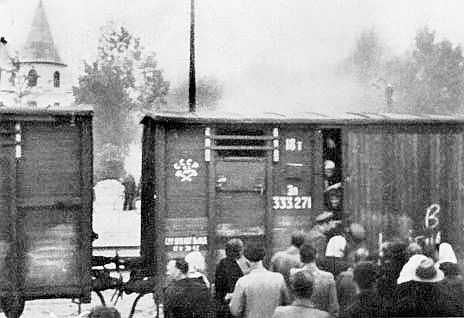The Soviet executed a number of mass deportations during and after WWII. The first was conducted June 14, 1941. The victims were gathered in more than 50 assembly points and carted away in more than 600 railway carriages—many nothing but cattle cars with a hole in a corner for bodily functions.
 Deportees being packed off to Siberia1
Deportees being packed off to Siberia1Farming families were particularly hard-hit, as were former members of the National Guard (Aizsargi) and anyone who had been a member of any sort of political organization. Scouts and guides were deported as "anti-Soviet elements." Landowners and merchants were also targeted.
Entire families were carted away—of the approximately 15,000 ripped away from their homes that day—a fraction of the 35,000 lost during the first Soviet occupation—more than 5,000 were women, more than 3,000, children. Families were torn apart as the men were deported separately to labor camps deep in the GULAG. Our families were among these. Nor was this the first such deportation—a tool dating back to the Tsarist Empire and to be used again after the war.
Mass Deportation of June 14, 19412
Instructions on how to carry out mass deportations were prepared in the autumn of 1939 for the newly-annexed regions of western Ukraine by the head of the Ukrainian SSR NKVD (later known as KGB), General Ivan Serov. They were approved in Moscow and later used in the Baltic States as well. As the USSR Commissar for State Security, Serov signed the orders on 21 January 1941.
In the night between 13 and 14 June, about 15,500 Latvian residents—among them 2400 children younger than ten—were arrested without a court order to be deported to distant regions in the Soviet Union. Targeted were mainly families who had members in leading positions in state and local governments, economy and culture.
People to be deported were awakened in the night and given less than one hour to prepare for the journey. They were allowed to take with them only what they could carry, and everything left behind was confiscated by the state. The unfortunate were herded into already prepared cattle or freight railroad cars, in which they spent weeks and months. Many died on the way, especially infants, the sick, and the elderly. Men, totalling some 8250, were separated from their families, arrested, and sent to GULAG hard labour camps. Women and children were taken to so-called "administrative settlements" as family members of "enemies of the people"
No word of these events was mentioned in Latvia's Soviet-censored newspapers. Loved ones had no way of knowing what had become of those deported. None of the institutions, including the militia, provided information or help. Scattered along the railroad tracks were farewell notes written by the deported to their families—few of them ever reached their intended recipients.
Conditions in the hard labour camps were inhumane. The inmates lost their identities, and were terrorised by the guards and criminal prisoners. Food rations were meagre, and did not replace the calories expended through work. People grew weak, and were crippled by diarrhoea, scurvy, and other illnesses. Winters were marked by unbearable cold, and many did not survive the first one. Only a small part of those deported in 1941 later returned to Latvia. The families in forced settlement had to fend for themselves in harsh conditions; the death rate among the very young and the elderly was likewise high.
| 1 | Original at Wikipedia, http://en.wikipedia.org/wiki/File:Latvia_deportation_1941.jpg |
| 2 | Excerpted from Soviet Mass Deportations from Latvia, a briefing paper of the Museum of the Occupation of Latvia. |
Database of the first mass deportation
- Personu
meklēšana LVA datu bāze, a searchable database of 15,443 individuals,
showing name, age, and family relationship, at the Latvian State Archive,
listing those taken in the first Soviet mass deportation of June 14, 1941. The
prompts are as follow:
- Vārds un/vai uzvārds: Name and/or surname
- Dzimšanas gads: Year of birth
- Apriņķis, pagasts: District, parish (county), "Visos" means in all
- Atcelt (button): Cancel
- Meklēt (button): Search
- We have also resumed work on reproducing the pages of names as they appear in These Names Accuse. There are names in the book which do not appear in the online database.
Additional reading
- Kolyma, the Land of Gold and Death, by Stanislaw J. Kowalski, a chilling and compelling first-hand story of the frozen wastelands of Siberia, with facts and figures.
- The Jamestown Foundation: the Gulag Collection, a collection of paintings by GULAG survivor Nikolai Getman, who passed away in 2004 at the age of 86. Getman appointed the Foundation to be curator of his works.
- Man Is Wolf to Man: Surviving the Gulag, by Janusz Bardach, Kathleen Gleeson, on the struggle to keep one's self, and one's humanity, alive.
- Keeping culture alive
- DP Refugees
- Deported to Siberia
- Latvian Legion POWs
 Gallery
Gallery